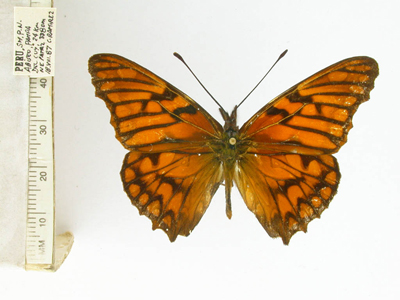Dione glycera
Margarita BeltránCharacteristics
Early stages: Eggs are yellow and approximately 1.2 x 0.9 mm (h x w). Females usually place eggs singly under leaves of the host plant. Mature larvae have a black body with yellow stripes, with black scoli and black and orange head; length is around 0.4 cm. Caterpillars are gregarious in small numbers (Brown, 1981).
Habits
Dione glycera occurs in the high Andes in cloud forests. Usually individuals fly rapidly in the middlestory. Adults roost in loose groups at night lower than 2 m above ground on grass blades leaves (Brown, 1981).
Hostplant: D. glycera larvae feed primarily on plants from the genus Distephana, Tacsonia, and Plectostema (Brown, 1981).
References
Brown K. S. 1981 The Biology of Heliconius and Related Genera. Annual Review of Entomology 26, 427-456.
Felder C. and Rudolf F. 1861 Lepidoptera nova Columbiae. Wiener entomologische Monatschrift 5(3): 72-87 (March), (4): 97-111.
Title Illustrations

| Scientific Name | Dione glycera |
|---|---|
| Specimen Condition | Dead Specimen |
| View | dorsal |
| Collection | Gerardo Lamas |
| Image Use |
 This media file is licensed under the Creative Commons Attribution-NonCommercial-ShareAlike License - Version 3.0. This media file is licensed under the Creative Commons Attribution-NonCommercial-ShareAlike License - Version 3.0.
|
| Copyright |
©

|
| Scientific Name | Dione glycera |
|---|---|
| Specimen Condition | Dead Specimen |
| View | ventral |
| Collection | Gerardo Lamas |
| Image Use |
 This media file is licensed under the Creative Commons Attribution-NonCommercial-ShareAlike License - Version 3.0. This media file is licensed under the Creative Commons Attribution-NonCommercial-ShareAlike License - Version 3.0.
|
| Copyright |
©

|
About This Page

University of Cambridge, Cambridge, UK
Correspondence regarding this page should be directed to Margarita Beltrán at
Page copyright © 2007
 Page: Tree of Life
Dione glycera .
Authored by
Margarita Beltrán.
The TEXT of this page is licensed under the
Creative Commons Attribution-NonCommercial-ShareAlike License - Version 3.0. Note that images and other media
featured on this page are each governed by their own license, and they may or may not be available
for reuse. Click on an image or a media link to access the media data window, which provides the
relevant licensing information. For the general terms and conditions of ToL material reuse and
redistribution, please see the Tree of Life Copyright
Policies.
Page: Tree of Life
Dione glycera .
Authored by
Margarita Beltrán.
The TEXT of this page is licensed under the
Creative Commons Attribution-NonCommercial-ShareAlike License - Version 3.0. Note that images and other media
featured on this page are each governed by their own license, and they may or may not be available
for reuse. Click on an image or a media link to access the media data window, which provides the
relevant licensing information. For the general terms and conditions of ToL material reuse and
redistribution, please see the Tree of Life Copyright
Policies.
- First online 21 February 2007
- Content changed 04 September 2008
Citing this page:
Beltrán, Margarita. 2008. Dione glycera . Version 04 September 2008 (under construction). http://tolweb.org/Dione_glycera/72864/2008.09.04 in The Tree of Life Web Project, http://tolweb.org/










 Go to quick links
Go to quick search
Go to navigation for this section of the ToL site
Go to detailed links for the ToL site
Go to quick links
Go to quick search
Go to navigation for this section of the ToL site
Go to detailed links for the ToL site